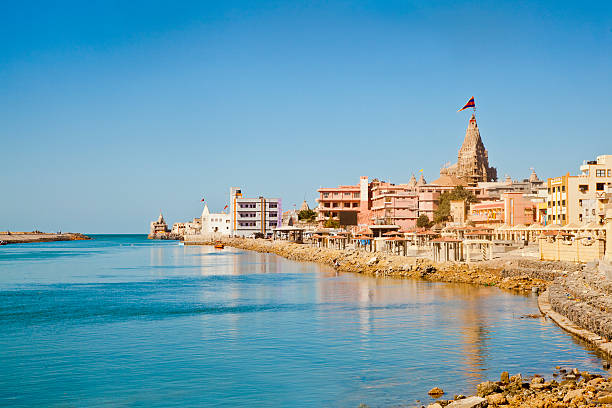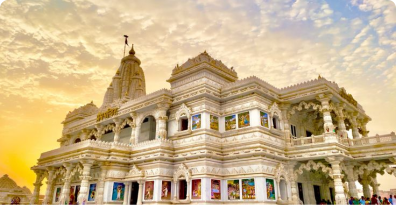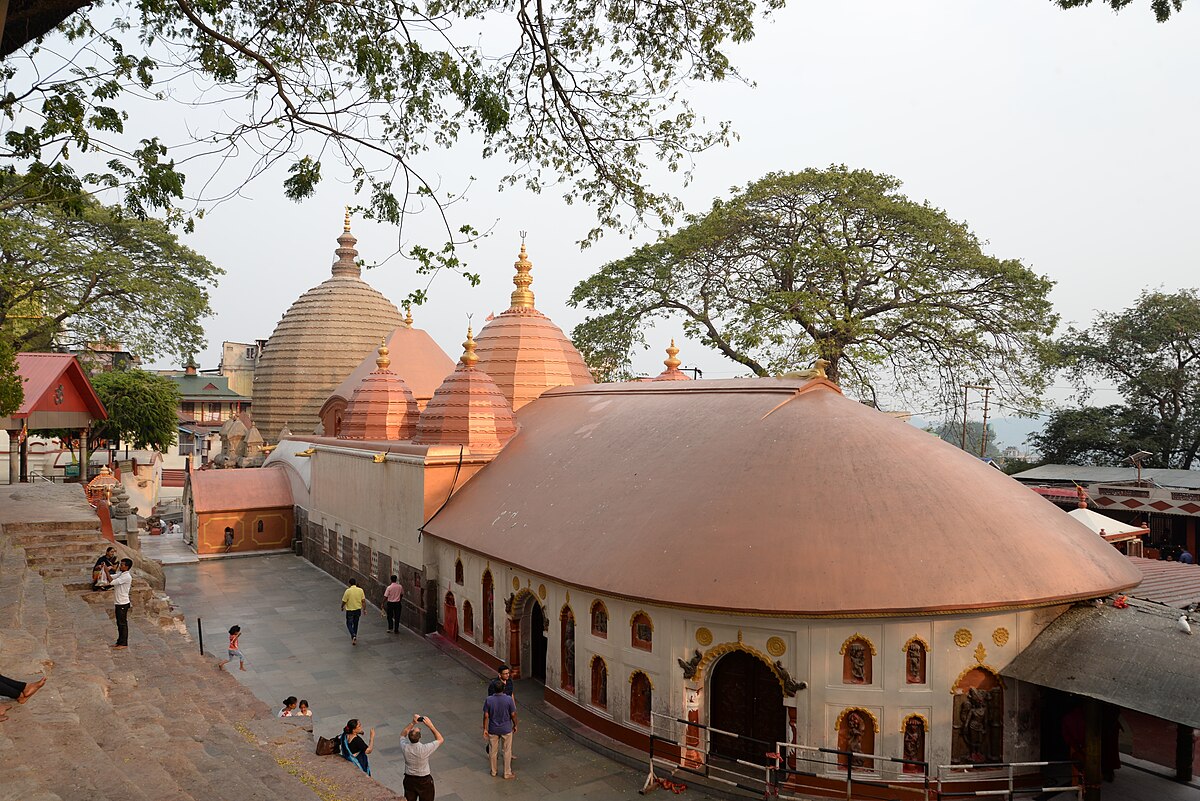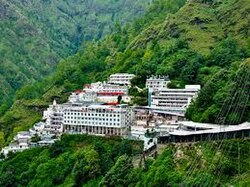
October 06, 2025
Temple Mandir
5 min read
Dwarka: The Lost City of Lord Krishna
Perched on the western coast of Gujarat, the Dwarkadhish Temple—also known as the Temple of Lord Krishna—is one of India’s most sacred pilgrimage sites. Believed to be the kingdom of Lord Krishna, Dwarka holds immense spiritual significance and is counted among the Char Dham pilgrimage destinations. The temple’s majestic architecture, golden spire, and intricately carved pillars reflect centuries of devotion and artistry. Legends say that visiting Dwarka and offering prayers to Lord Krishna here can fulfill wishes and bring spiritual bliss. Beyond its religious aura, Dwarka exudes a timeless charm, blending mythology, history, and culture, making it a must-visit for devotees and travelers alike.
Dwarka: The Lost City of Lord Krishna
Introduction
Dwarka, often referred to as the "Golden City" or "City of Lord Krishna," is one of the most significant and enigmatic cities in Hindu mythology. According to ancient texts, it was a flourishing kingdom ruled by Lord Krishna, situated on the western coast of India. However, after Krishna's departure from the mortal world, the city is believed to have been submerged beneath the sea, leading to its mysterious disappearance. This blog delves into the historical background, mysterious facts, reasons for its downfall, and the folk myths surrounding the lost city of Dwarka.
Historical Background
The Foundation of Dwarka
The city of Dwarka is mentioned in several ancient Hindu scriptures, including the Mahabharata, Bhagavata Purana, and Vishnu Purana. According to these texts, Dwarka was established by Lord Krishna after he left his birthplace, Mathura, to escape the tyranny of his uncle Kamsa. Krishna is said to have reclaimed 12 yojanas (approximately 96 square kilometers) of land from the sea to build the city, making it a marvel of ancient engineering and urban planning. The city was designed with grand palaces, temples, and fortified walls, reflecting its status as a prosperous and powerful kingdom.
Dwarka as a Cultural and Religious Hub
Dwarka was not only a political center but also a significant cultural and religious hub. It housed the Dwarkadhish Temple, dedicated to Lord Krishna, which attracted pilgrims from all over the Indian subcontinent. The city was also a center for art, literature, and commerce, with bustling markets and thriving trade routes connecting it to other ancient civilizations.
Mysterious Facts
Submersion Beneath the Sea
One of the most intriguing aspects of Dwarka's history is its sudden submersion beneath the sea. According to the Mahabharata, after Lord Krishna's departure from the mortal world, the city was submerged by the ocean as a divine act, marking the end of an era. This event has been a subject of fascination and speculation for centuries.
Archaeological Discoveries
In recent decades, underwater archaeological explorations off the coast of Dwarka have uncovered submerged structures that resemble the descriptions found in ancient texts. Researchers have discovered massive stone walls, pillars, and artifacts dating back thousands of years, suggesting the existence of a sophisticated civilization beneath the sea. Radiocarbon dating of some of these artifacts indicates that they could be over 9,000 years old, challenging conventional historical timelines.
ElHuffPost
The Gulf of Khambhat Findings
The Gulf of Khambhat, located off the coast of Gujarat, has been the focal point of many underwater excavations. Divers have reported finding large, well-structured stone blocks and formations that align with the descriptions of Dwarka's architecture in ancient scriptures. These findings have led some researchers to propose that the submerged city could be the legendary Dwarka, providing a tangible link between mythology and history.
Medium
Reasons for the Downfall
Divine Intervention
According to Hindu mythology, the submersion of Dwarka was a divine act following Lord Krishna's departure from the mortal world. It is believed that the ocean swallowed the city as a sign of the end of the Yadava dynasty and the onset of the Kali Yuga, the age of darkness and decline. This narrative emphasizes the cyclical nature of time in Hindu cosmology, where creation, preservation, and destruction are ongoing processes.
Natural Disasters
Some scholars and scientists suggest that the submersion of Dwarka could have been the result of natural disasters such as earthquakes, tsunamis, or rising sea levels. The region is seismically active, and geological studies have indicated that ancient coastal cities in the area have been affected by such events. The sudden submersion could have been a catastrophic event triggered by these natural forces.
Decline of the Yadava Dynasty
The Mahabharata also narrates the internal strife and moral decline of the Yadava dynasty, Krishna's clan, which led to its downfall. The Yadavas were cursed to destroy each other in a fratricidal war, leading to their extinction. This internal collapse could have weakened the city's defenses and contributed to its eventual submersion.
Folk Myths and Legends
The Curse of the Yadavas
One of the most popular folk myths surrounding Dwarka is the curse of the Yadavas. It is believed that after Lord Krishna's departure, the Yadava men, intoxicated by liquor, began to quarrel and kill each other. This act of violence was seen as a fulfillment of a curse, leading to the extinction of the Yadava dynasty and the submersion of Dwarka.
The Sudama Bridge
According to legend, a bridge known as the Sudama Setu once connected Dwarka to the mainland. The bridge was said to have been built by Lord Krishna to facilitate the visit of his childhood friend Sudama. However, after Krishna's departure, the bridge collapsed, and the city was swallowed by the sea, leaving behind only remnants of its grandeur.
The Eternal Flame
Another folk myth speaks of an eternal flame that once burned in Dwarka, symbolizing the divine presence of Lord Krishna. It is said that the flame continued to burn even after the city's submersion, serving as a beacon for lost souls and a reminder of the city's former glory.
Conclusion
Dwarka, the legendary city of Lord Krishna, continues to captivate the imagination of people worldwide. While its exact historical existence remains a topic of debate, the myths, legends, and archaeological findings associated with it offer a fascinating glimpse into India's rich cultural and spiritual heritage. Whether viewed through the lens of mythology or history, Dwarka stands as a testament to the enduring legacy of Lord Krishna and the mysteries of ancient civilizations.
Introduction
Dwarka, often referred to as the "Golden City" or "City of Lord Krishna," is one of the most significant and enigmatic cities in Hindu mythology. According to ancient texts, it was a flourishing kingdom ruled by Lord Krishna, situated on the western coast of India. However, after Krishna's departure from the mortal world, the city is believed to have been submerged beneath the sea, leading to its mysterious disappearance. This blog delves into the historical background, mysterious facts, reasons for its downfall, and the folk myths surrounding the lost city of Dwarka.
Historical Background
The Foundation of Dwarka
The city of Dwarka is mentioned in several ancient Hindu scriptures, including the Mahabharata, Bhagavata Purana, and Vishnu Purana. According to these texts, Dwarka was established by Lord Krishna after he left his birthplace, Mathura, to escape the tyranny of his uncle Kamsa. Krishna is said to have reclaimed 12 yojanas (approximately 96 square kilometers) of land from the sea to build the city, making it a marvel of ancient engineering and urban planning. The city was designed with grand palaces, temples, and fortified walls, reflecting its status as a prosperous and powerful kingdom.
Dwarka as a Cultural and Religious Hub
Dwarka was not only a political center but also a significant cultural and religious hub. It housed the Dwarkadhish Temple, dedicated to Lord Krishna, which attracted pilgrims from all over the Indian subcontinent. The city was also a center for art, literature, and commerce, with bustling markets and thriving trade routes connecting it to other ancient civilizations.
Mysterious Facts
Submersion Beneath the Sea
One of the most intriguing aspects of Dwarka's history is its sudden submersion beneath the sea. According to the Mahabharata, after Lord Krishna's departure from the mortal world, the city was submerged by the ocean as a divine act, marking the end of an era. This event has been a subject of fascination and speculation for centuries.
Archaeological Discoveries
In recent decades, underwater archaeological explorations off the coast of Dwarka have uncovered submerged structures that resemble the descriptions found in ancient texts. Researchers have discovered massive stone walls, pillars, and artifacts dating back thousands of years, suggesting the existence of a sophisticated civilization beneath the sea. Radiocarbon dating of some of these artifacts indicates that they could be over 9,000 years old, challenging conventional historical timelines.
ElHuffPost
The Gulf of Khambhat Findings
The Gulf of Khambhat, located off the coast of Gujarat, has been the focal point of many underwater excavations. Divers have reported finding large, well-structured stone blocks and formations that align with the descriptions of Dwarka's architecture in ancient scriptures. These findings have led some researchers to propose that the submerged city could be the legendary Dwarka, providing a tangible link between mythology and history.
Medium
Reasons for the Downfall
Divine Intervention
According to Hindu mythology, the submersion of Dwarka was a divine act following Lord Krishna's departure from the mortal world. It is believed that the ocean swallowed the city as a sign of the end of the Yadava dynasty and the onset of the Kali Yuga, the age of darkness and decline. This narrative emphasizes the cyclical nature of time in Hindu cosmology, where creation, preservation, and destruction are ongoing processes.
Natural Disasters
Some scholars and scientists suggest that the submersion of Dwarka could have been the result of natural disasters such as earthquakes, tsunamis, or rising sea levels. The region is seismically active, and geological studies have indicated that ancient coastal cities in the area have been affected by such events. The sudden submersion could have been a catastrophic event triggered by these natural forces.
Decline of the Yadava Dynasty
The Mahabharata also narrates the internal strife and moral decline of the Yadava dynasty, Krishna's clan, which led to its downfall. The Yadavas were cursed to destroy each other in a fratricidal war, leading to their extinction. This internal collapse could have weakened the city's defenses and contributed to its eventual submersion.
Folk Myths and Legends
The Curse of the Yadavas
One of the most popular folk myths surrounding Dwarka is the curse of the Yadavas. It is believed that after Lord Krishna's departure, the Yadava men, intoxicated by liquor, began to quarrel and kill each other. This act of violence was seen as a fulfillment of a curse, leading to the extinction of the Yadava dynasty and the submersion of Dwarka.
The Sudama Bridge
According to legend, a bridge known as the Sudama Setu once connected Dwarka to the mainland. The bridge was said to have been built by Lord Krishna to facilitate the visit of his childhood friend Sudama. However, after Krishna's departure, the bridge collapsed, and the city was swallowed by the sea, leaving behind only remnants of its grandeur.
The Eternal Flame
Another folk myth speaks of an eternal flame that once burned in Dwarka, symbolizing the divine presence of Lord Krishna. It is said that the flame continued to burn even after the city's submersion, serving as a beacon for lost souls and a reminder of the city's former glory.
Conclusion
Dwarka, the legendary city of Lord Krishna, continues to captivate the imagination of people worldwide. While its exact historical existence remains a topic of debate, the myths, legends, and archaeological findings associated with it offer a fascinating glimpse into India's rich cultural and spiritual heritage. Whether viewed through the lens of mythology or history, Dwarka stands as a testament to the enduring legacy of Lord Krishna and the mysteries of ancient civilizations.


